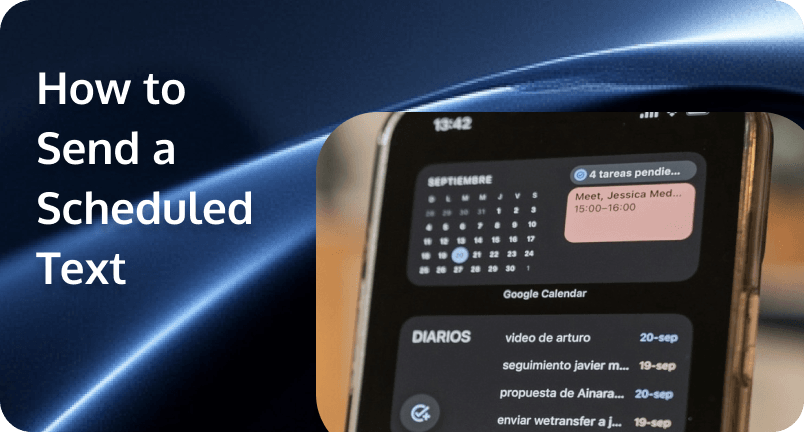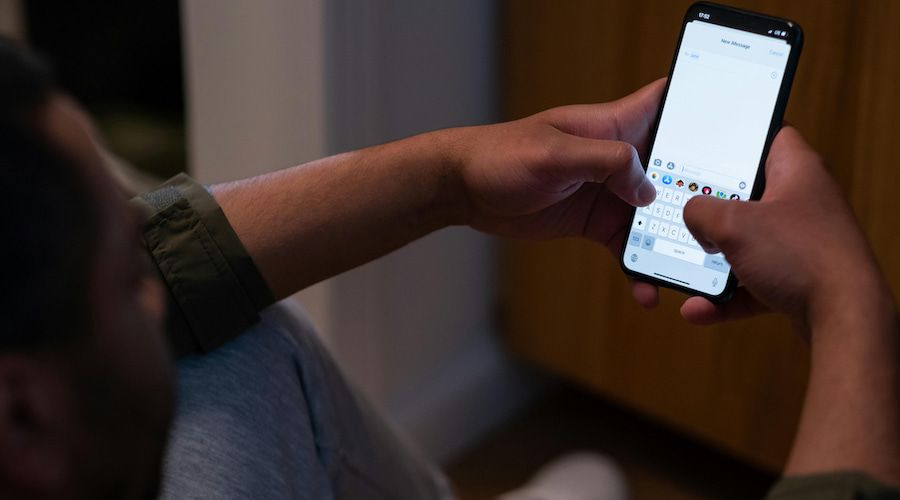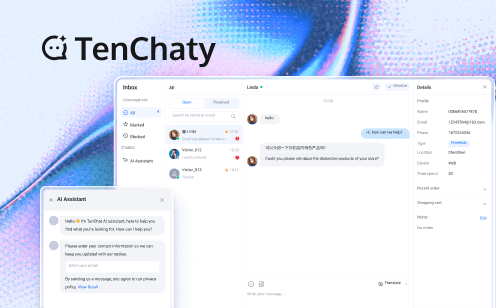 Wishing you could send a text at just the right time without having to remember? Whether you want to send a birthday message right at midnight, remind a colleague about an upcoming meeting, or follow up with a client during business hours, scheduling a text can be a lifesaver.
Wishing you could send a text at just the right time without having to remember? Whether you want to send a birthday message right at midnight, remind a colleague about an upcoming meeting, or follow up with a client during business hours, scheduling a text can be a lifesaver.
Fortunately, both iPhone and Android devices offer multiple ways to automate text messages. In this guide, we’ll walk you through how to send a scheduled text using both built-in apps and third-party options, ensuring your messages are always delivered at the right moment.
 How to Send a Scheduled Text on iPhone?
How to Send a Scheduled Text on iPhone?
With the release of iOS 18, Apple introduced the “Send Later” feature, allowing you to schedule text messages directly within the Messages app. For devices not running iOS 18, you can always use workarounds like Shortcuts or Reminders.
Here’s how to schedule send a text on iPhone:
Use the Messages app
If your iPhone is updated to iOS 18, you can schedule messages directly within the Messages app:
1. Launch the Messages app and select an existing conversation or start a new one.
2. Type the message you wish to schedule.
3. Tap the ‘+’ icon next to the text field and select “Send Later”.
4. Choose the desired date and time for your message to be sent.
5. Tap the send button (blue arrow) to schedule your message.
Your scheduled message will appear in the conversation with a dashed line, indicating it’s pending. You can schedule messages up to 14 days in advance.
To manage your scheduled messages:
● Edit or Reschedule: Locate the scheduled message in your conversation. Tap “Edit” next to the scheduled time. Choose “Edit Time” to set a new sending time or “Send Message” to send it immediately.
● Delete a Scheduled Message: Press and hold the scheduled message bubble. Tap “Delete” to remove it.
Use the Shortcuts app
For iPhones not running iOS 18, the Shortcuts app allows you to automate message scheduling:
1. Launch the Shortcuts app and navigate to the “Automation” tab.
2. Tap the “+” icon on the right corner or click on the “New Automation” on the center.
3. Select “Time of Day” to specify when you want the message to be sent and then tap the “Next” on the right corner.
4. Search for “Send Message”, enter the recipient and message content, then click on “Done”.
5. Enable “Run Immediately” to send the message automatically without prompts.
6. Tap “Done” to finalize the automation.
While effective, it’s important to note that the Shortcuts app will not automatically send the message when the phone is locked. When finished, you can delete the automation in case of repetitive reminders.
Use the Reminders app
While the Reminders app doesn’t send messages automatically, it can prompt you to send a pre-composed message at a specific time:
1. Open the Reminders app and tap on the “New Reminder” in the bottom left corner.
2. Type the title and message you intend to send on the corresponding “Title” and “Note” fields.
3. Once typed, tap “Details” to set your specific date and time. You can also classify your events by selecting “Priority”—Low, Medium, or High. If needed, head to Settings and enable Precise Location for Reminders to ensure more accurate notifications.
4. When finished, tap “Add”. You could also add “When Messaging” and include a contact name.
5. Once set, click “Done” to save the reminder.
6. When the reminder notification pops up, you can copy the message from your reminder.
7. Open the Messages app, paste the copied message, and hit “Send”.
Besides, you can also combine reminders with Siri for hands-free scheduling:
1. Tell Siri, “Remind me to text [contact] at [time].”
2. When the reminder alerts you, tap the notification.
3. Use Siri again: “Send a message to [contact] saying [message].”
How to Send a Scheduled Text on Android?
Using an Android? Scheduling text messages on your Android device is just as easy. Here’s how you can do it:
Use the Google Messages app
Google Messages, the default messaging app for many Android devices, has an integrated feature that allows you to schedule texts directly. Here’s how to use it:
1. Open Google Messages and compose your message.
2. Once the message is ready, long-press the “Send” button (the paper plane icon ➤).
3. A scheduling menu will appear. You can select the time and date you want the message to send, and press “Save.”
4. The message will automatically be sent at the scheduled time.
Use the Google Calendar app
While Google Calendar doesn't send text messages directly, it can send email reminders or notifications at scheduled times. To set up a reminder:
1. Open the Calendar app. Tap “+” to create a new event and set its date and time.
2. In the event’s title and description, type your message and the recipient’s number. For example, “Text John at 555-1234: Meeting at 3 PM”).
3. Set a reminder to notify you to send the text.
4. When the reminder pops up, you’ll be prompted to manually send the text. You can quickly copy and paste the text to your message app to send it on time.
Use the Samsung Messages app
For Samsung users, the native Samsung Messages app provides a straightforward way to schedule texts:
1. Open the Samsung Messages app and type your message, including text and recipient.
2. Now, tap the “+” button on the left and select “Schedule message” from the menu.
3. Choose the date and time you want the message to be sent and tap “Done.”
4. The message will automatically be sent at the selected time.
Third-Party Apps for Text Scheduling
While native messaging apps on iOS and Android offer basic scheduling features, third-party applications can provide enhanced functionality and flexibility. Here are some highly-rated apps that allow you to schedule text messages:
WhatsApp + SKEDit: Cross-Platform
While WhatsApp lacks native scheduling, third-party tools like SKEDit (Android/iOS) bypass this by automating message delivery. SKEDit uses accessibility permissions to simulate manual sending at set times.
Scheduled: iOS
A dedicated iMessage scheduler, Scheduled integrates seamlessly with Apple’s ecosystem. It supports batch message scheduling, recurring texts, and time-zone adjustments. Technical highlights include end-to-end encryption for security, iMessage API integration, and compatibility with Focus Mode to avoid interruptions.
TextLater: iOS
This app simplifies delayed messaging with a clean interface. Features include SMS/iMessage scheduling, message templates, and cloud sync via iCloud. It uses Apple’s Core Data framework for offline functionality and supports Shortcuts app integration for automated workflows.
AutoSender: iOS
Designed for power users, AutoSender offers API access for custom automation (e.g., triggering texts based on calendar events). It supports conditional messaging (e.g., “Send if the recipient replies”) and integrates with iOS Contacts and Reminders.
Pulse SMS: Android
A fan favorite, Pulse SMS enables cross-device texting via web or tablet. Its scheduling feature includes recurring messages, send-later timers, and MMS support. Technically, it employs encryption for synced data.
Textra SMS: Android
Known for its customization, Textra combines scheduling with themes, bubble styles, and delayed sending. It uses standard Android’s SMS/MMS API to ensure messages are sent reliably, even in low-power mode.
Build a Messaging App with Text Scheduling Using TRTC
If you’re a developer looking to build a messaging app that supports easy text scheduling and real-time communication, TRTC’s Chat solution is a powerful choice.
Developed by Tencent Cloud, TRTC offers low-latency, high-quality messaging, along with audio and video communication capabilities, making it ideal for building chat applications with robust scheduling and automation features.
TRTC’s Chat solution provides multi-platform APIs, server-side APIs, webhooks, and UIkit components, enabling quick integration with minimal coding effort. You can get started with just a few lines of code while enjoying the following features:
● Rich Media Messages: Send text, images, audio, and video messages seamlessly.
● Threaded Replies: Enable users to respond directly to specific messages in a conversation thread.
● Message Essentials: Support offline messaging, message recall, read receipts, typing indicators, push notifications, and chat history exports.
● Message Analytics: Monitor and optimize user experience with real-time usage and quality metrics.
● Security & Compliance: Ensure data privacy with TLS/SSL encryption, file security, and user data deletion options.
● Message Translation: Communicate effortlessly with support for over 100+ languages for global messaging.
With TRTC Chat, you can build a full-fledged messaging app that not only supports scheduled messaging but also delivers a seamless, secure, and interactive user experience. Whether you’re creating a business communication tool, a social chat app, or an in-app messaging system, TRTC provides the reliability and scalability you need.
Conclusion
Scheduling texts is a simple way to stay on top of your communication without stressing about timing. Whether you’re using your Messages apps’ built-in features or third-party tools, you now know exactly how to send a scheduled text whenever you need to. No more forgetting important messages or scrambling to send reminders at the last minute—just set it and forget it! Give it a try and see how much easier managing your texts can be.
FAQs
How to send a scheduled text on an iPhone?
To send a scheduled text on an iPhone, use the Messages app (iOS 18+): compose your message, tap “+” > “Send Later”, set the time, and send. For older iOS versions, use the Shortcuts app: create a Personal Automation, set a time trigger, add the Send Message action, and disable Run After Confirmation. Alternatively, set a reminder in the Reminders app to manually send the text.
Can you set a time for a text to send to someone?
Yes, you can schedule a text message to be sent at a specific time on both iPhone and Android. On iPhone, you can use the Shortcuts app or Reminders app, and if you’re on iOS 18 or later, the Messages app has a built-in “Send Later” feature. On Android, you can use the Google Messages app, Samsung Messages app, or third-party apps to schedule texts easily.
Why can’t I schedule a message on my iPhone?
On iPhones, you can’t schedule messages directly in the Messages app unless you’re using iOS 18 or later, which includes a “Send Later” feature. If your iPhone doesn’t support iOS 18, you’ll need to use the Shortcuts app to automate scheduled texts or set a Reminders notification to manually send the message at a specific time. Alternatively, third-party apps like Scheduled can help with text scheduling.
Do scheduled texts work if my phone is off?
For many methods, scheduled texts will only send if your phone is turned on and connected to a network at the scheduled time. If your phone is off or lacks service, the message will be delayed until it’s back online. However, on iPhones running iOS 18 or later, scheduled messages are sent via Apple’s servers, allowing them to be delivered even if your phone is offline.


